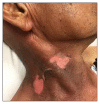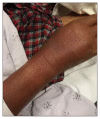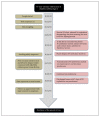Stevens-Johnson Syndrome/Toxic Epidermal Necrolysis and Treatment With a Biologic: A Case Report
- PMID: 28488978
- PMCID: PMC5424646
- DOI: 10.7812/TPP/16-060
Stevens-Johnson Syndrome/Toxic Epidermal Necrolysis and Treatment With a Biologic: A Case Report
Abstract
Introduction: One of the most dangerous dermatologic emergencies is Stevens-Johnson Syndrome (SJS)/toxic epidermal necrolysis (TEN). Although a rare disease, it can often lead to significant mortality.
Case presentation: In this case report, we present a 77-year-old man who developed a sloughing rash that was secondary to a nonsteroidal anti-inflammatory drug. In addition to the recommended supportive care, the patient was treated with etanercept, a new, less commonly used intervention.
Discussion: We provide a brief review of SJS/TEN. Nonsteroidal anti-inflammatory drugs are a rare cause of SJS/TEN, and additionally, the use of biologics is a novel treatment modality for SJS/TEN.
Conflict of interest statement
The author(s) have no conflicts of interest to disclose.
Figures





Similar articles
-
Pediatric Stevens-Johnson Syndrome/Toxic Epidermal Necrolysis Halted by Etanercept.J Cutan Med Surg. 2018 Sep/Oct;22(5):514-515. doi: 10.1177/1203475418758989. Epub 2018 Feb 9. J Cutan Med Surg. 2018. PMID: 29421925
-
Stevens-Johnson Syndrome and Toxic Epidermal Necrolysis: A Concise Review with a Comprehensive Summary of Therapeutic Interventions Emphasizing Supportive Measures.Adv Ther. 2017 Jun;34(6):1235-1244. doi: 10.1007/s12325-017-0530-y. Epub 2017 Apr 24. Adv Ther. 2017. PMID: 28439852 Free PMC article. Review.
-
Management of Stevens-Johnson Syndrome/Toxic Epidermal Necrolysis: A Case Report and Literature Review.J Drugs Dermatol. 2023 Nov 1;22(11):e24-e28. doi: 10.36849/JDD.6999. J Drugs Dermatol. 2023. PMID: 37943271 Review.
-
Pediatric SJS/TEN Subdued by a Combination of Dexamethasone, Cyclosporine, and Etanercept.J Cutan Med Surg. 2019 Sep/Oct;23(5):547-550. doi: 10.1177/1203475419861078. J Cutan Med Surg. 2019. PMID: 31478770
-
The use of etanercept for treatment of toxic epidermal necrolysis when toxic shock syndrome is in the differential.Dermatol Ther. 2018 Sep;31(5):e12684. doi: 10.1111/dth.12684. Epub 2018 Sep 2. Dermatol Ther. 2018. PMID: 30175438
Cited by
-
Current Perspectives on Stevens-Johnson Syndrome and Toxic Epidermal Necrolysis.Clin Rev Allergy Immunol. 2018 Feb;54(1):147-176. doi: 10.1007/s12016-017-8654-z. Clin Rev Allergy Immunol. 2018. PMID: 29188475 Review.
-
A Review of the Systemic Treatment of Stevens-Johnson Syndrome and Toxic Epidermal Necrolysis.Biomedicines. 2022 Aug 28;10(9):2105. doi: 10.3390/biomedicines10092105. Biomedicines. 2022. PMID: 36140207 Free PMC article. Review.
-
Survey of Nonprescription Medication and Antibiotic Use in Patients with Stevens-Johnson Syndrome, Toxic Epidermal Necrolysis, and Overlap Syndrome.Antibiotics (Basel). 2018 Feb 1;7(1):11. doi: 10.3390/antibiotics7010011. Antibiotics (Basel). 2018. PMID: 29389866 Free PMC article.
-
Current Pharmacogenetic Perspective on Stevens-Johnson Syndrome and Toxic Epidermal Necrolysis.Front Pharmacol. 2021 Apr 26;12:588063. doi: 10.3389/fphar.2021.588063. eCollection 2021. Front Pharmacol. 2021. PMID: 33981213 Free PMC article. Review.
-
Biologic TNF-α Inhibitors for Stevens-Johnson Syndrome, Toxic Epidermal Necrolysis, and TEN-SJS Overlap: A Study-Level and Patient-Level Meta-Analysis.Dermatol Ther (Heidelb). 2023 Jun;13(6):1305-1327. doi: 10.1007/s13555-023-00928-w. Epub 2023 May 13. Dermatol Ther (Heidelb). 2023. PMID: 37178320 Free PMC article.
References
-
- Ward KE, Archambault R, Mersfelder TL. Severe adverse skin reactions to nonsteroidal antiinflammatory drugs: A review of the literature. Am J Health Syst Pharm. 2010 Feb 1;67(3):206–13. DOI: https://doi.org/10.2146/ajhp080603. - DOI - PubMed
-
- Morelli MS, O’Brien FX. Stevens-Johnson syndrome and cholestatic hepatitis. Dig Dis Sci. 2001 Nov;46(11):2385–8. DOI: https://doi.org/10.1023/A:1012351231143. - DOI - PubMed
-
- Roujeau JC, Kelly JP, Naldi L, et al. Medication use and the risk of Stevens-Johnson syndrome or toxic epidermal necrolysis. N Engl J Med. 1995 Dec 14;333(24):1600–7. DOI: https://doi.org/10.1056/NEJM199512143332404. - DOI - PubMed
-
- Gerull R, Nelle M, Schaible T. Toxic epidermal necrolysis and Stevens-Johnson syndrome: A review. Crit Care Med. 2011 Jun;39(6):1521–32. DOI: https://doi.org/10.1097/CCM.0b013e31821201ed. - DOI - PubMed
-
- Stevens AM, Johnson FC. A new eruptive fever associated with stomatitis and ophthalmia: Report of two cases in children. Am J Dis Child. 1922 Dec;24(6):526–33. https://doi.org/10.1001/archpedi.1922.04120120077005. - DOI
Publication types
MeSH terms
Substances
LinkOut - more resources
Full Text Sources
Other Literature Sources

